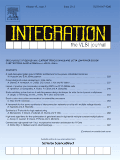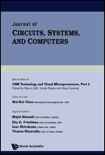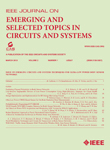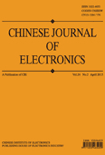
INTEGRATION-THE VLSI JOURNAL
Scope & Guideline
Elevating Knowledge in Hardware and Architecture
Introduction
Aims and Scopes
- Integrated Circuit Design and Implementation:
The journal emphasizes novel methodologies and technologies for designing integrated circuits, including analog, digital, and mixed-signal circuits, with a focus on improving performance and reducing power consumption. - Hardware Security and Cryptography:
Research on hardware security measures, including Physical Unclonable Functions (PUFs), secure cryptographic implementations, and techniques to counteract hardware attacks, is a significant focus of the journal. - Neurocomputing and Machine Learning Applications:
The integration of machine learning algorithms into VLSI design and architecture is a growing area of interest, with papers exploring neural network implementations and hardware accelerators. - Emerging Technologies and Novel Devices:
The journal covers innovative devices such as memristors and their applications in circuits and systems, alongside research on advanced materials and fabrication techniques. - Reliability and Fault Tolerance in VLSI Systems:
Research addressing the reliability of VLSI systems, including soft error mitigation strategies, aging effects, and fault-tolerant design techniques, is prominently featured. - High-Performance Computing Architectures:
Topics related to high-performance computing, including FPGA and ASIC designs optimized for specific applications, are integral to the journal's scope. - Signal Processing and Communication Systems:
The journal publishes research on VLSI architectures for signal processing applications and communication systems, focusing on efficiency and performance improvements.
Trending and Emerging
- Machine Learning and AI in VLSI Design:
There is a significant increase in research exploring the integration of machine learning techniques for optimizing VLSI design, including automated synthesis and intelligent routing. - Memristive and Neuromorphic Computing:
The use of memristors and neuromorphic computing architectures is gaining traction, with studies focusing on their applications in efficient computing and advanced signal processing. - Energy-Efficient Computing Solutions:
A strong trend towards energy-efficient designs is evident, particularly in the context of IoT and wearable devices, reflecting growing environmental concerns and energy costs. - 3D Integration and Packaging Technologies:
Research on 3D integration techniques and advanced packaging methods is emerging as a key area, driven by the need for higher performance and compact designs. - Robustness and Reliability Enhancements:
Increasing attention is being paid to enhancing the robustness and reliability of VLSI systems, particularly in the context of soft error resilience and aging effects. - Quantum and Hybrid Computing Architectures:
There is a burgeoning interest in exploring quantum computing principles within VLSI design, particularly in creating hybrid systems that leverage both classical and quantum techniques. - Advanced Security Mechanisms:
Research into advanced security mechanisms, including hardware-based security solutions and cryptographic methods, is on the rise, reflecting heightened concerns over cybersecurity.
Declining or Waning
- Traditional Analog Circuit Design:
Research focusing on conventional analog circuit design techniques appears less frequently, as the field shifts towards more integrated and digital approaches. - Basic CMOS Technology Studies:
There is a waning interest in purely theoretical or foundational studies related to basic CMOS technologies, likely due to the rapid advancements and availability of more sophisticated technologies. - Low-Level Hardware Verification Techniques:
Papers centered on low-level hardware verification methods are appearing less often, possibly overshadowed by more advanced verification techniques that leverage machine learning and AI. - Single-Use Specialized Devices:
The focus on single-use or niche devices is declining as the market and research community lean towards versatile, multi-functional integrated solutions. - Static Design Methodologies:
Static design methodologies that do not incorporate adaptive or dynamic elements are seeing reduced attention, as there is a growing preference for designs that can adapt to varying conditions.
Similar Journals

JOURNAL OF CIRCUITS SYSTEMS AND COMPUTERS
Exploring the Intersection of Hardware and ArchitectureJOURNAL OF CIRCUITS SYSTEMS AND COMPUTERS is a pivotal publication in the fields of Electrical and Electronic Engineering as well as Hardware and Architecture, published by World Scientific Publishing Co. Pte Ltd in Singapore. With an ISSN of 0218-1266 and an E-ISSN of 1793-6454, this journal has contributed significantly to the discourse surrounding innovative research and technological advancements since its inception in the late 1990s. It currently holds a Q3 ranking in both relevant categories, reflecting its competitive stature and providing researchers, professionals, and students a substantial platform for disseminating findings. The journal covers a diverse range of topics, focusing on the design, analysis, and application of circuits, systems, and advanced computing technologies. Authors benefit from a rigorous peer-review process, ensuring high-quality publications that drive the field forward. The journal's commitment to excellence underscores its importance in fostering academic collaboration and knowledge exchange, making it a vital resource for anyone dedicated to advancing the domains of electrical engineering and computer science.

Journal of Cryptographic Engineering
Driving excellence in cryptographic research and secure technologies.The Journal of Cryptographic Engineering, published by Springer Heidelberg, is a prominent platform dedicated to advancing the field of cryptography and its applications in secure communication and information security technologies. With the ISSN 2190-8508 and E-ISSN 2190-8516, this journal showcases rigorous and innovative research contributions from 2011 to 2024, reflecting its commitment to excellence in academic publishing. Recognized among the Q2 category in Computer Networks and Communications and Software, it ranks impressively within the Scopus framework, securing positions in the 59th and 54th percentiles respectively. The Journal aims to facilitate a comprehensive understanding of cryptographic techniques, promote collaboration among researchers, and provide a vital resource for students and professionals. By maintaining high standards of peer review and providing a platform for cutting-edge research, it plays a crucial role in shaping the future of cryptographic engineering.

IEEE Journal on Emerging and Selected Topics in Circuits and Systems
Illuminating pathways in electrical engineering research.IEEE Journal on Emerging and Selected Topics in Circuits and Systems is a prestigious peer-reviewed journal published by the IEEE - Institute of Electrical and Electronics Engineers, aimed at advancing the field of electrical and electronic engineering. With its ISSN of 2156-3357 and E-ISSN of 2156-3365, this journal has established itself as a leader in the exploration of innovative concepts and applications within circuits and systems since its inception in 2011. It is recognized for its high impact factor, being categorized in the Q1 Quartile for electrical engineering in 2023, and is ranked 126 out of 797 journals in the field, placing it in the 84th percentile according to Scopus rankings. As a valuable resource for researchers, professionals, and students alike, the journal focuses on emerging technologies and selected topics that contribute to the evolution of circuit designs, signal processing, and system architecture. Although it does not offer open access, the relevance and content of the journal ensure it remains at the forefront of electrical engineering discourse, continually fostering innovation and knowledge dissemination among the scientific community.

CIRCUITS SYSTEMS AND SIGNAL PROCESSING
Exploring Innovative Solutions in Systems and Signal ProcessingCIRCUITS, SYSTEMS AND SIGNAL PROCESSING, published by Springer Birkhauser, is a highly regarded journal in the fields of applied mathematics and signal processing, boasting an impact factor that reflects its robust academic contributions. Established in 1982, this journal aims to disseminate cutting-edge research that bridges the gap between theoretical advancements and practical applications in circuit design, systems theory, and signal processing. With a Thomason Scopus ranking of Q2 in Applied Mathematics and Q3 in Signal Processing, it stands out as a leading resource for researchers, professionals, and students seeking to enhance their knowledge and innovate within these disciplines. The journal provides insight into the latest trends and technologies, making it an essential reading for those engaged in the development of signal processing methodologies. Although it does not offer Open Access options, it remains a critical repository of knowledge with deep relevance in today's tech-driven landscape.

CHINESE JOURNAL OF ELECTRONICS
Connecting Scholars with Cutting-edge Engineering DiscoveriesThe CHINESE JOURNAL OF ELECTRONICS is a distinguished peer-reviewed publication in the fields of electrical and electronic engineering and applied mathematics, published by the reputable IEEE-Institute of Electrical and Electronics Engineers Inc. Based in the United States, this journal has been a significant platform for sharing innovative research since its inception in 1996. With a commendable impact factor, it is ranked Q3 in both applied mathematics and electrical engineering categories, reflecting its relevance and quality within the academic community. The journal aims to disseminate high-quality research, foster interdisciplinary approaches, and provide a forum for discussions on advancements and applications in electronics and associated fields. Although it currently does not offer open access, the CHINESE JOURNAL OF ELECTRONICS remains a key resource for researchers, professionals, and students seeking to stay at the forefront of technological developments. Its Scopus rankings—170th in applied mathematics and 365th in electrical engineering—highlight its credibility and importance in advancing knowledge and innovation.

ANALOG INTEGRATED CIRCUITS AND SIGNAL PROCESSING
Unleashing Potential in Integrated Circuit DesignANALOG INTEGRATED CIRCUITS AND SIGNAL PROCESSING is a distinguished journal published by SPRINGER, specializing in the dynamic fields of hardware architecture and signal processing. Established in 1991, the journal serves as a vital resource for cutting-edge research and developments in analog circuit design, integrated circuits, and their applications in various signal processing techniques. With an impact factor reflective of its relevance, it holds a respectable position within the Q3 quartile across key categories including Hardware and Architecture, Signal Processing, and Surfaces, Coatings and Films, demonstrating its commitment to quality and innovation. The journal's presence in Scopus rankings further emphasizes its value, housing works that influence both academia and industry. While the journal currently does not offer open access options, it remains dedicated to providing researchers, professionals, and students with rigorously peer-reviewed articles that contribute significantly to the advancement of the field. Its headquarters in the Netherlands, at VAN GODEWIJCKSTRAAT 30, 3311 GZ DORDRECHT, positions it within a thriving academic environment that fosters ongoing exploration and collaboration.

IEEE Open Journal of Circuits and Systems
Empowering engineers with open access to research.Welcome to the IEEE Open Journal of Circuits and Systems, a premier platform dedicated to disseminating high-quality research in the field of electrical engineering and circuit design. Published by the prestigious IEEE-INST ELECTRICAL ELECTRONICS ENGINEERS INC, this journal embraces an Open Access model since its inception in 2020, facilitating unrestricted access to cutting-edge advancements for researchers, professionals, and students alike. With the rapid evolution of circuits and systems technology, this journal aims to serve as a vital resource for promoting innovative ideas, sharing interdisciplinary research, and fostering collaboration among the global engineering community. The E-ISSN 2644-1225 signifies our commitment to digital publication and the accessibility of research findings. As the field continues to expand, we encourage submissions that explore the latest trends, methodologies, and applications, ensuring that our readers remain at the forefront of knowledge in this dynamic domain.

JOURNAL OF COMMUNICATIONS TECHNOLOGY AND ELECTRONICS
Unveiling Breakthroughs in Technology and Electronics.JOURNAL OF COMMUNICATIONS TECHNOLOGY AND ELECTRONICS, published by PLEIADES PUBLISHING INC, is a prominent academic journal dedicated to advancing the fields of communications technology, electronics, and materials science. With an ISSN of 1064-2269 and an E-ISSN of 1555-6557, this journal has been a pivotal resource since its inception in 1995, providing a platform for researchers and professionals to disseminate and explore groundbreaking studies and innovations up to the year 2024. Although currently categorized in Quartile 4 for Condensed Matter Physics and Quartile 3 for Electrical and Electronic Engineering, it continues to thrive in its role, offering insights and findings that contribute to its evolving impact within these disciplines. Researchers will find valuable content that emphasizes critical advancements in technology and materials, supported by robust Scopus rankings that highlight its competitive standing within its category. With no open access option, the journal provides exclusive access to its subscribers to delve into high-quality peer-reviewed articles, making it an essential resource for those at the forefront of scientific inquiry and innovation.

Journal of Signal Processing Systems for Signal Image and Video Technology
Advancing Innovations in Signal Processing and Imaging.Journal of Signal Processing Systems for Signal Image and Video Technology, published by SPRINGER, is a leading interdisciplinary journal dedicated to advancing research and development in the fields of signal processing, image processing, and video technology. With an ISSN of 1939-8018 and an E-ISSN of 1939-8115, this journal emphasizes both theoretical and practical applications, boasting a wide scope that ranges from control and systems engineering to hardware architecture. Since its inception in 2008, it has gained a solid reputation, reflected in its 2023 category quartile rankings—including Q2 in Control and Systems Engineering and Q3 in Signal Processing—demonstrating its significance within the academic community. The journal is underpinned by a commitment to open access, promoting broad dissemination of knowledge, and is particularly vital for researchers, professionals, and students looking to contribute to and stay updated in these rapidly evolving fields. With ongoing explorations into the convergence of technology and methodology until 2024, the journal stands as a crucial resource for the latest innovations and discussions in signal processing systems.

IEEE Circuits and Systems Magazine
Elevating the Standards of Electrical and Computer ScienceIEEE Circuits and Systems Magazine is a prestigious publication, renowned for its contributions to the disciplines of Electrical and Electronic Engineering and Computer Science Applications. Published by the esteemed IEEE-INST ELECTRICAL ELECTRONICS ENGINEERS INC, this magazine boasts a significant standing in the academic community, reflected in its Q1 ranking in both categories for the year 2023. With converged years from 1979 to 1984 and currently continuing from 2001 to 2024, it serves as a vital resource for emerging research, trends, and technological advancements in the field. Although it operates under a traditional access model, the magazine is an essential platform for researchers and practitioners to disseminate their innovative ideas, making meaningful contributions to the development of circuits and systems technologies. The magazine is headquartered in Piscataway, NJ, USA, fostering a global academic network committed to excellence in engineering research.